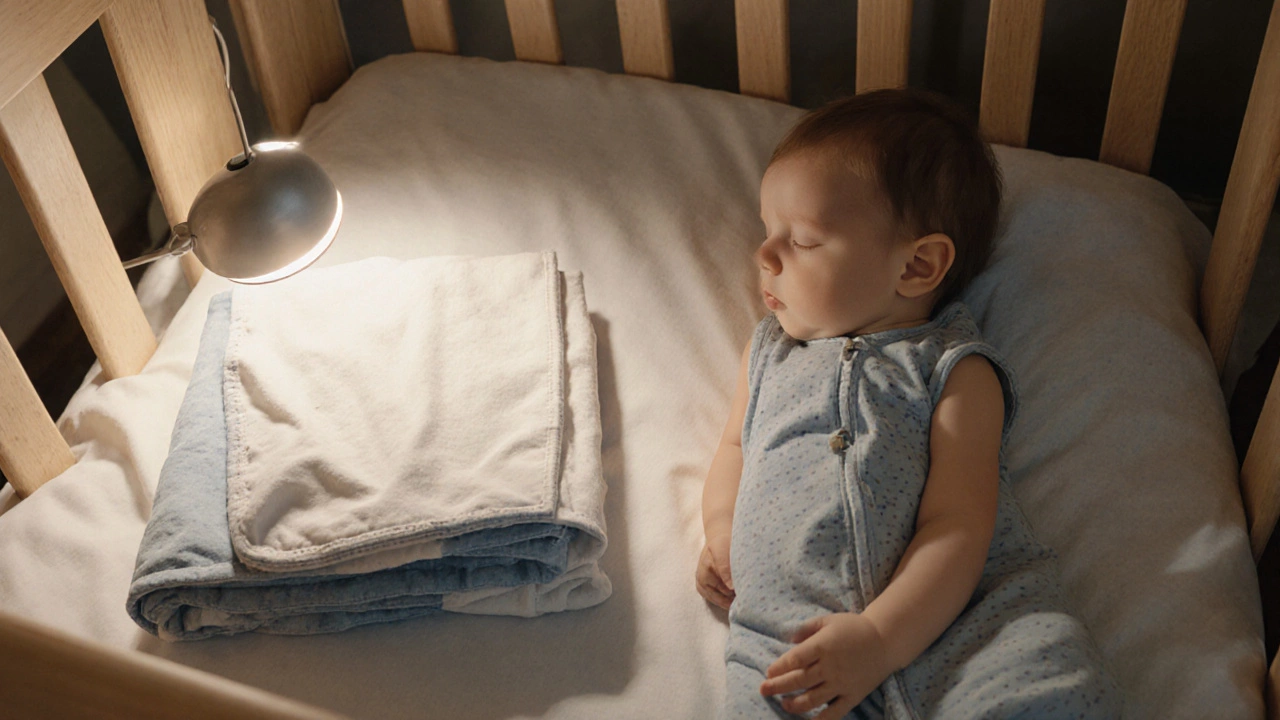Toddler Sleep Transition Calculator
Assess your child's readiness based on safety signs from the article. This tool helps determine if your toddler is ready to safely switch from a sleep sack to a blanket.
When to Switch from Sleep Sack to Blanket for Toddlers
You’ve been cozying up your toddler in a sleep sack for months-maybe even years. It’s warm, it’s safe, and it keeps them from kicking off the covers. But now they’re turning two, climbing out of the crib, and asking for a blanket like their big sister. When to switch from sleep sack to blanket isn’t just about age-it’s about readiness, safety, and your child’s development.
The short answer? Most toddlers are ready between 18 and 24 months. But that’s not a rule. Some kids are ready at 15 months. Others still need the security of a sack at 30 months. The key isn’t the calendar-it’s the signs your child is showing.
Signs Your Toddler Is Ready for a Blanket
Don’t rush the transition just because your friend’s kid switched at two. Watch for these real-life cues:
- They’re climbing out of the crib-safety becomes a bigger concern than keeping them warm.
- They’re pulling the sleep sack off during the night, tossing it aside, or trying to wear it like a shirt.
- They’ve started sleeping on a toddler bed or mattress on the floor, where blankets are more practical.
- They’re asking for a blanket, or pointing at one in a picture book.
- They’re sleeping through the night without waking up cold or tangled.
I’ve seen parents switch too early because they wanted to ‘grow up’ their child’s sleep setup. Then the toddler wakes up shivering every hour, or gets tangled in a too-big blanket and panics. That’s not progress-it’s regression.
Why Sleep Sacks Are Safe (and Why Blankets Aren’t Always)
The American Academy of Pediatrics (AAP) recommends keeping babies and toddlers in sleep sacks until they’re at least 12 months old, and often longer. Why? Because loose blankets in a crib or bed are a known suffocation risk. Even a lightweight cotton blanket can cover a toddler’s face if they roll over or kick during deep sleep.
Sleep sacks eliminate that risk. They’re fitted, they stay put, and they keep your child at a safe, consistent temperature. No need to layer extra sheets or worry about the blanket sliding over their head.
But once your child can roll, sit up, crawl, and climb, their motor skills improve. They can move a blanket away if it’s too heavy. They can kick it off if they’re too hot. That’s when the safety equation changes.

How to Make the Switch Safely
Don’t go from full-body sack to a full-size duvet overnight. Ease into it.
- Start with a lightweight, breathable blanket. Look for cotton or bamboo muslin. Avoid fluffy quilts, down comforters, or thick fleece. These trap heat and can be hard to move.
- Use a fitted sheet and a small, thin blanket. Tuck it in snugly on two sides, leaving the bottom open so your toddler can kick it off if needed.
- Try a transitional product. Some brands make ‘sleep sacks with detachable arms’ or ‘blanket sleepers’ that act as a bridge. These let your child move their arms freely while still feeling wrapped.
- Test it during naptime first. If they handle a blanket during a 1-hour nap without getting tangled or cold, you’re on the right track.
- Keep the room temperature steady. Between 18-20°C (65-68°F) is ideal. Use a simple room thermometer. If it’s too warm, they’ll kick the blanket off. Too cold, and they’ll shiver.
One parent in Melbourne told me her son switched at 22 months after he started wearing pajamas with feet. She added a thin cotton blanket and tucked it under the mattress on the sides. He slept through the night for the first time in months.
What to Avoid
There are common mistakes that turn a smooth transition into a sleep disaster.
- Don’t use a twin-sized blanket. Too big means too much fabric to get tangled in. Stick to a 100 x 135 cm (40 x 53 inch) size for toddlers.
- Don’t layer blankets. One thin blanket is safer than two. Overheating is a bigger risk than being cold.
- Don’t wait until after a major change. If your toddler just moved to a big kid bed, started daycare, or had a big life shift, give them time to adjust before adding another change.
- Don’t assume all sleep sacks are the same. Some have long sleeves, others are sleeveless. If your child is already moving their arms freely, a sleeveless sack might be the last step before a blanket.
What If They Still Hate the Blanket?
Not every toddler takes to blankets right away. And that’s okay.
Some kids just feel more secure in a sack. If your child is still sleeping well, not overheating, and not climbing out of bed, there’s no rush. Keep using the sack. Many kids use them until age three or even four. The goal isn’t to ‘grow out’ of it-it’s to keep them safe and well-rested.
If you’re worried they’re too old for a sack, remember: there’s no official cutoff. Pediatricians don’t say ‘you must stop at two.’ They say ‘stop when they can safely manage a blanket.’
I’ve met toddlers who still use sleep sacks because they’re deep sleepers and their parents don’t want to risk a blanket slipping over their face. That’s not lazy parenting. That’s smart parenting.

What to Do If They Get Tangled
Even after switching, accidents happen. If your toddler wakes up with the blanket wrapped around their neck or head:
- Stay calm. Don’t yell or rush. Speak softly.
- Untangle gently. Don’t pull hard.
- Reassure them. Say, ‘I’ve got you. You’re safe.’
- Go back to the sleep sack for a few more weeks, then try again.
It’s normal for kids to struggle at first. The first few nights might be bumpy. But most adjust within a week or two.
When to Call the Pediatrician
Most transitions are fine. But if your child shows any of these, talk to your doctor:
- Frequent night wakings with panic or crying after switching to a blanket.
- Signs of overheating-sweating, flushed skin, rapid breathing.
- They’re consistently cold, even with layers.
- They have a history of sleep apnea, reflux, or developmental delays.
These aren’t reasons to panic. They’re signals that your child might need a different approach-maybe a weighted sleep sack, a different room temp, or even a sleep consultant.
Final Thoughts: It’s About Readiness, Not Rules
There’s no magic age when every toddler should switch from a sleep sack to a blanket. It’s not a milestone like walking or talking. It’s a practical shift based on safety, skill, and comfort.
If your child is climbing out of the crib, sleeping through the night, and showing interest in a blanket-go for it. If they’re still snuggling into their sack like a little burrito? Let them. There’s no prize for being the first to ditch the sack.
Focus on safe sleep. Focus on restful nights. And remember: the goal isn’t to grow out of the sleep sack-it’s to grow into better sleep.
Can my 12-month-old use a blanket instead of a sleep sack?
No. The American Academy of Pediatrics advises against loose blankets in cribs until at least 12 months, and even then, only if your child can roll, sit up, and move the blanket away. Most experts recommend waiting until 18-24 months. At 12 months, your child still lacks the motor skills to safely manage a blanket in the crib.
Is a sleep sack safer than a blanket for toddlers?
Yes, until your child can reliably move, roll, and remove a blanket on their own. Sleep sacks eliminate the risk of suffocation from fabric covering the face. Once your toddler is in a bed and can move freely, a thin, breathable blanket becomes safe-and often more comfortable.
What kind of blanket is best for toddlers?
Choose a lightweight, breathable cotton or bamboo muslin blanket, around 100 x 135 cm (40 x 53 inches). Avoid fluffy, thick, or down-filled blankets. Tuck it in on two sides to keep it from sliding over their head. A wearable blanket with sleeves can be a good middle step.
Should I stop using a sleep sack cold turkey?
No. Ease into it. Start by using the blanket during naps, then gradually introduce it at night. Keep the sleep sack available for a few weeks in case your child gets cold or anxious. Many parents use a sleeveless sack as a transition before going fully to a blanket.
My toddler keeps kicking off the blanket. What should I do?
It’s normal. Toddlers move a lot in sleep. Try a slightly heavier cotton blanket, or use a sleep sack with removable arms. You can also try pajamas with feet to keep their legs warm. Don’t pile on more blankets-that increases overheating risk. Instead, check the room temperature and dress them in a long-sleeve onesie underneath.
